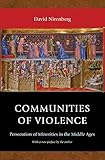Communities of Violence : Persecution of Minorities in the Middle Ages - Updated Edition / David Nirenberg.
Material type: TextPublisher: Princeton, NJ : Princeton University Press, [2015]Copyright date: ©2015Edition: Updated edition with a New preface by the authorDescription: 1 online resourceContent type:
TextPublisher: Princeton, NJ : Princeton University Press, [2015]Copyright date: ©2015Edition: Updated edition with a New preface by the authorDescription: 1 online resourceContent type: - 9780691165769
- 9781400866236
- 305.8/0094 23
- D164 .N574 2015eb
- online - DeGruyter
- Issued also in print.
| Item type | Current library | Call number | URL | Status | Notes | Barcode | |
|---|---|---|---|---|---|---|---|
 eBook
eBook
|
Biblioteca "Angelicum" Pont. Univ. S.Tommaso d'Aquino Nuvola online | online - DeGruyter (Browse shelf(Opens below)) | Online access | Not for loan (Accesso limitato) | Accesso per gli utenti autorizzati / Access for authorized users | (dgr)9781400866236 |
Frontmatter -- CONTENTS -- PREFACE TO THE NEW PAPERBACK EDITION -- ACKNOWLEDGMENTS -- ABBREVIATIONS -- Introduction -- Chapter 1. The historical background -- Part one. Cataclysmic violence: France and the Crown of Aragon -- CHAPTER 2. France, Source of the Troubles: Shepherds' Crusade and Lepers' Plot (1320, 1321) -- Chapter 3. CRUSADE AND MASSACRE IN ARAGON (1320) -- Chapter 4. LEPERS, JEWS, MUSLIMS, AND POISON IN THE CROWN (1321) -- Part two. Systemic Violence: Power, Sex, and Religion -- Chapter 5. SEX AND VIOLENCE BETWEEN MAJORITY AND MINORITY -- Chapter 6. MINORITIES CONFRONT EACH OTHER: VIOLENCE BETWEEN MUSLIMS AND JEWS -- Chapter 7. THE TWO FACES OF SACRED VIOLENCE -- Epilogue. THE BLACK DEATH AND BEYOND -- BIBLIOGRAPHY OF WORKS CITED -- INDEX
In the wake of modern genocide, we tend to think of violence against minorities as a sign of intolerance, or, even worse, a prelude to extermination. Violence in the Middle Ages, however, functioned differently, according to David Nirenberg. In this provocative book, he focuses on specific attacks against minorities in fourteenth-century France and the Crown of Aragon (Aragon, Catalonia, and Valencia). He argues that these attacks--ranging from massacres to verbal assaults against Jews, Muslims, lepers, and prostitutes--were often perpetrated not by irrational masses laboring under inherited ideologies and prejudices, but by groups that manipulated and reshaped the available discourses on minorities. Nirenberg shows that their use of violence expressed complex beliefs about topics as diverse as divine history, kinship, sex, money, and disease, and that their actions were frequently contested by competing groups within their own society. Nirenberg's readings of archival and literary sources demonstrates how violence set the terms and limits of coexistence for medieval minorities. The particular and contingent nature of this coexistence is underscored by the book's juxtapositions--some systematic (for example, that of the Crown of Aragon with France, Jew with Muslim, medieval with modern), and some suggestive (such as African ritual rebellion with Catalan riots). Throughout, the book questions the applicability of dichotomies like tolerance versus intolerance to the Middle Ages, and suggests the limitations of those analyses that look for the origins of modern European persecutory violence in the medieval past.
Issued also in print.
Mode of access: Internet via World Wide Web.
In English.
Description based on online resource; title from PDF title page (publisher's Web site, viewed 23. Mai 2019)


